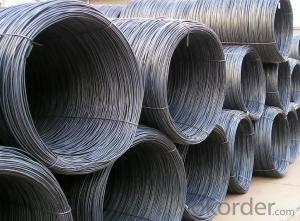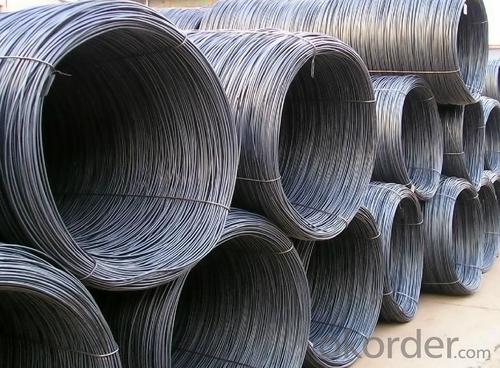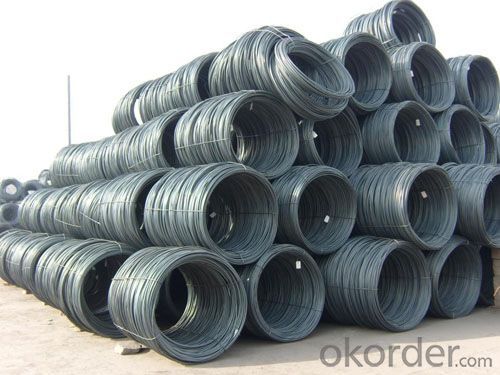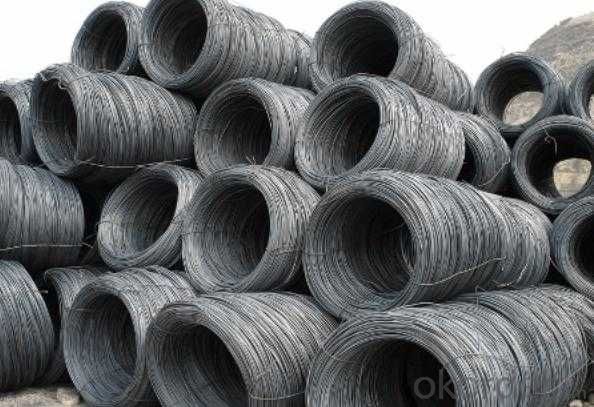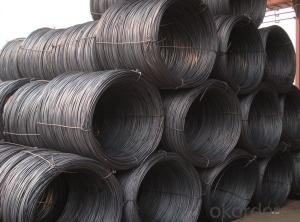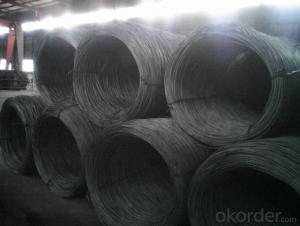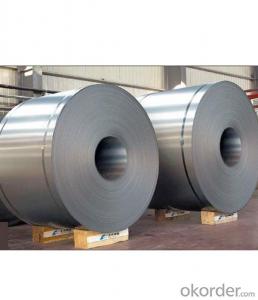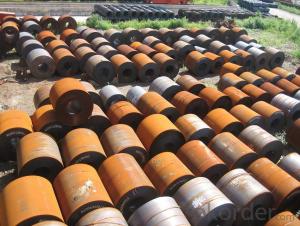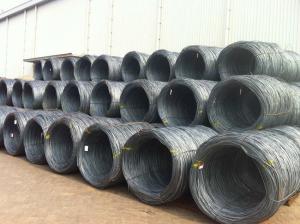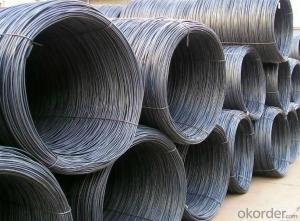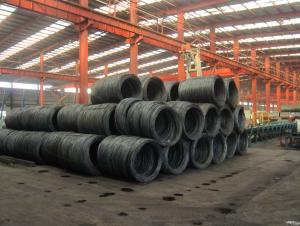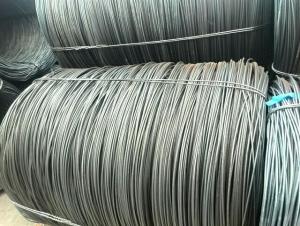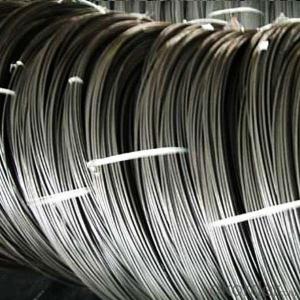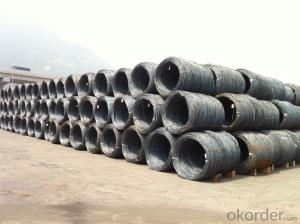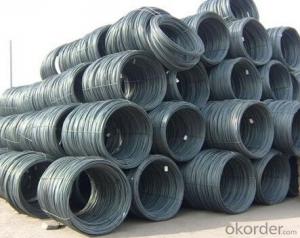GB Standard Q195 Steel Wire Rod with High Quality
- Loading Port:
- China Main Port
- Payment Terms:
- TT or LC
- Min Order Qty:
- 40 m.t
- Supply Capability:
- 15000 m.t/month
OKorder Service Pledge
OKorder Financial Service
You Might Also Like
Product Description:
Specifications of GB Standard Q195 Steel Wire Rod with High Quality:
Steel Grade: Q195 Standard:GB
Diameter: 5.5mm
6.5mm can be drawing into 2mm/8.0mm can be drawing into 3mm
Type: Drawn Wire in Coil, each coil weight about 2MT
Chemical Composition:
Please kindly find our chemistry of our material based on Q195 as below for your information
Trademark | Rank | Chemical composition (quality score) % | |||||
C | Si | Mn | S | P | |||
| ≤ |
| ≤ | ≤ | |||
Q195 |
| 0.06-0.12 | 0.30 | 0.25 | 0.050 | 0.045 | |
Trademark | Rank | Pulling Test | |||||
Bend PointΔs/Mpa | Tensile Strength | Elongation Ratioδ5% | |||||
Thickness (Diameter) /MM | Thickness (Diameter) /MM | ||||||
≤16 | 16-40 | ≤16 | 16-40 | ||||
≥ | ≥ | ||||||
Q195 |
| 195 | 185 | 315-390 | 33 | 32 | |
Usage and Applications of GB Standard Q195 Steel Wire Rod with High Quality:
After hot-rolled the products shaped into coil and delivery as finished product, including round, square, rectangular, hexagonal and so on. Since most of the products are round, it is generally called wire rod. Carbon steel wire rod is widely used in construction and manufacturing. Carbon steel wire rod is mainly used for reinforcement of reinforced concrete and welded structure or reprocessed (roberts , nail, etc.) materials, especially used to produce wire drawing, welding electrode, nails, spring, electronic, precise machinery parts and so on.
Production Process of GB Standard Q195 Steel Wire Rod with High Quality:
Steel billet---Heating---Rolling---Water-cooling---Coiling---Cooling---Inspection---Bundling---Exworks
Packaging & Delivery of GB Standard Q195 Steel Wire Rod with High Quality:
Packaging Detail: products are packed in coil and then shipped by container or bulk vessel
Each coil weight: About 2MT
Delivery Detail: within 45 days after received deposit or LC.
Label: to be specified by customer, generally, each bundle has 1-2 labels
Trade terms: FOB, CFR, CIF
FAQ:
Q1: How soon can we receive the product after purchasement?
A1: Within three days of placing an order, we will begin production. The specific shipping date is dependent upon international and government factors, but is typically one month.
Q2: How do you guarantee the quality of our products?
A2: We have established an advanced quality management system which conducts strict quality tests at every step, from raw materials to the final product. At the same time, we provide extensive follow-up service assurances as required.
Q3: The prices are invoicing on theoritical weight or on actual weight?
A3: We can do it in both manners, according to the customers' request.
Images of GB Standard Q195 Steel Wire Rod with High Quality:
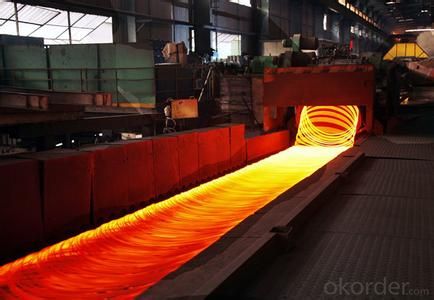
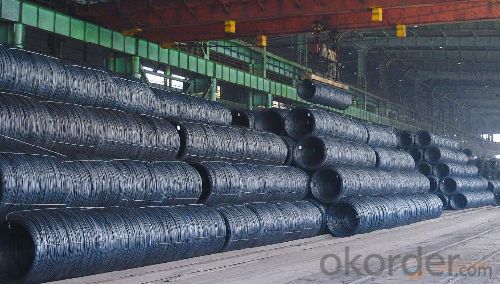
*If you would like to get our price, please kindly inform us the size, standard/material and quantity. Thank you very much for your attention.
- Q: What are the trends in the steel wire rod market?
- The trends in the steel wire rod market include increased demand due to infrastructure development, automotive industry growth, and the rising popularity of steel wire rods in construction and manufacturing sectors. Additionally, there is a shift towards the production of high-quality and technologically advanced steel wire rods, as well as a focus on sustainability and environmental regulations.
- Q: How is steel wire rod tested for elongation?
- Steel wire rod is tested for elongation using a tensile test, where a sample of the rod is pulled until it breaks. The change in length of the sample is measured and expressed as a percentage of its original length to determine its elongation.
- Q: How is steel wire rod packaged for transportation and storage?
- Steel wire rod is typically packaged in a manner that guarantees its protection and ease of handling during transportation and storage. To achieve this, a series of steps are taken to ensure the product's safety and integrity. Typically, steel wire rod is bundled together using steel straps or wires. These bundles are tightly secured to prevent any movement or damage while being transported. The size and weight of these bundles may vary depending on the specific requirements and dimensions of the wire rods. To offer further protection against external factors like moisture, dust, and corrosion, it is common to coat the wire rod with a layer of oil or other rust-resistant material. This coating helps maintain the wire rod's quality and durability while in storage or during transportation. The bundles of steel wire rod are then stacked and stored in a warehouse or on a pallet. This method ensures easy handling and efficient use of space. The pallets, made from wood, plastic, or metal, are designed to withstand the weight and pressure of the wire rod bundles. Additionally, they facilitate the use of forklifts or other lifting equipment for loading and unloading purposes. During transportation, steel wire rod is typically loaded onto trucks, trains, or ships for long-distance travel. Proper lifting equipment is employed during the loading and unloading process to ensure the bundles' safety and integrity. The wire rod bundles are securely fastened and secured to prevent any movement that could potentially cause damage. In summary, the packaging of steel wire rod for transportation and storage involves securely bundling, applying a protective coating, stacking and storing on pallets, and using appropriate lifting equipment. These measures are essential in guaranteeing the wire rod's safety, quality, and integrity throughout its journey from the manufacturing facility to its final destination.
- Q: What are the main factors influencing the choice of steel wire rod payment terms?
- The choice of payment terms for steel wire rod can be influenced by several key factors. One primary factor is the buyer's financial stability and creditworthiness. If the buyer is financially strong, the seller may be more inclined to offer favorable payment terms, such as longer payment periods or installment options. Conversely, if the buyer has a weak credit history or financial instability, the seller may require stricter payment terms, like upfront payment or shorter payment periods. Market conditions and competition also play a role in determining payment terms. In a highly competitive market with numerous suppliers, the seller may need to provide more flexible payment options to attract buyers. This could include deferred payment or payment upon delivery. On the other hand, in a market with limited suppliers or high demand, the seller may have more bargaining power and can impose stricter payment terms. The nature of the business relationship between the buyer and seller is another crucial consideration. If the buyer and seller have a longstanding relationship with a history of successful transactions, the seller may be more inclined to offer favorable payment terms as a sign of trust and loyalty. Additionally, the volume and frequency of purchases can also influence payment terms. Buyers who consistently buy large quantities of steel wire rod may have more leverage in negotiations and can secure more favorable payment terms. Lastly, external factors such as economic conditions, currency fluctuations, and government regulations can also impact payment terms. During times of economic uncertainty or currency volatility, sellers may exercise more caution and require stricter payment terms to mitigate risk. Similarly, government regulations pertaining to international trade or finance can also affect payment terms. In summary, the choice of payment terms for steel wire rod is influenced by factors such as the buyer's financial stability, market conditions, the nature of the business relationship, and external factors like economic conditions and government regulations.
- Q: How does the corrosion resistance of steel wire rod vary with different surface treatments?
- The corrosion resistance of steel wire rod can vary significantly with different surface treatments. Surface treatments such as galvanization, coating, or passivation can provide an additional layer of protection against corrosion by forming a barrier between the steel and the corrosive environment. These treatments can enhance the steel's resistance to rust, oxidation, and other forms of corrosion, thereby extending its lifespan and maintaining its structural integrity. However, the effectiveness of the treatment depends on various factors such as the type and thickness of the coating, the quality of the application, and the specific corrosive agents to which the steel wire rod is exposed.
- Q: How is steel wire rod made?
- Steel wire rod is made through a process called hot rolling, where steel billets are heated and passed through a series of rolling mills to reduce their diameter and increase their length. This continuous process enhances the mechanical properties of the steel, ensuring it meets the desired strength and flexibility requirements. The resulting wire rod is then coiled and cooled before being further processed into various applications such as nails, fences, or construction materials.
- Q: What are the different types of steel wire rod defects that can occur during manufacturing?
- During the production of steel wire rods, various defects can arise. These defects can be classified into different categories based on their characteristics and their impact on the final product. Some common defects found in steel wire rods include: 1. Surface defects: These defects occur on the outer surface of the wire rod and are visible to the naked eye. They can include cracks, scratches, pits, scale, or unevenness. Surface defects can affect both the appearance and functionality of the wire rod. 2. Internal defects: Internal defects are defects that occur within the structure of the wire rod and are not visible on the surface. They can include inclusions, cavities, blowholes, or voids. Internal defects can weaken the wire rod and reduce its mechanical properties, making it more susceptible to breakage or failure. 3. Dimensional defects: Dimensional defects refer to deviations from the desired size, shape, or tolerance of the wire rod. These defects can include variations in diameter, ovality, or straightness. Dimensional defects can affect the performance and suitability of the wire rod for specific applications. 4. Chemical composition defects: These defects occur when the chemical composition of the steel wire rod deviates from the specified standards. This can include variations in the levels of carbon, sulfur, phosphorus, or other alloying elements. Chemical composition defects can have a negative impact on the mechanical properties, corrosion resistance, or other desired characteristics of the wire rod. 5. Surface finish defects: Surface finish defects refer to imperfections in the smoothness, brightness, or cleanliness of the wire rod's surface. These defects can include scale, rust, stains, or uneven coating. Surface finish defects can affect the appearance, corrosion resistance, or further processing of the wire rod. 6. Mechanical property defects: Mechanical property defects occur when the wire rod does not meet the desired mechanical properties, such as tensile strength, yield strength, or elongation. These defects can result from improper heat treatment, incorrect rolling parameters, or material inconsistencies. Mechanical property defects can have an impact on the performance and reliability of the wire rod in its intended application. To ensure the production of high-quality steel wire rods without significant defects, manufacturers must adhere to strict quality control measures during the manufacturing process. Regular inspections, testing, and compliance with industry standards are essential in detecting and minimizing these defects.
- Q: How is steel wire rod straightened after the rolling process?
- Steel wire rod, after the rolling process, typically does not have a perfect straightness. To rectify this, there are multiple methods that can be utilized. One commonly used method is known as the straightening process, which includes passing the wire rod through a sequence of straightening rolls or dies. The initial set of rolls, through which the wire rod is fed, is usually inclined at an angle. As the rod passes through these rolls, it is bent in the opposite direction of its original curvature. The angle of the rolls is adjusted accordingly to gradually straighten the rod. This process is repeated with multiple sets of rolls, each set slightly altering the angle to further straighten the wire rod. Another method employed for straightening steel wire rod is the rotary straightening process. In this method, the wire rod is guided through a series of rotating straightening rolls. These rolls are often positioned at various angles to effectively straighten the rod. As the rod moves through the rolls, it undergoes bending forces that counteract its initial curvature, resulting in a straightened wire rod. Furthermore, there exist specialized machines and equipment designed specifically for straightening steel wire rod. These machines employ different mechanisms, such as hydraulic or mechanical systems, to apply controlled bending forces to the rod and straighten it. Overall, the process of straightening steel wire rod involves the application of controlled bending forces through sets of rolls or specialized machines. This gradual process serves to eliminate any curvature, resulting in a straightened wire rod that meets the necessary specifications.
- Q: What are the common production processes for palladium-coated steel wire rod?
- The common production processes for palladium-coated steel wire rod include wire drawing, cleaning and pre-treatment, palladium electroplating, and post-plating treatment.
- Q: What are the main challenges in steel wire rod production?
- Manufacturers typically encounter several primary challenges in the production of steel wire rods. One of these challenges involves the need to maintain consistent quality and uniformity in the wire rod products. Given that these products are utilized in various sectors like construction, automotive, and manufacturing industries, it becomes crucial to adhere to strict quality control measures that align with the specific requirements and standards of each sector. Another significant challenge lies in optimizing the production process to achieve high productivity and efficiency. The production of steel wire rods encompasses multiple stages, including melting, casting, rolling, and finishing. Each stage necessitates appropriate equipment, skilled operators, and precise control to minimize downtime, decrease waste, and maximize output. Manufacturers must continuously analyze and refine their production processes to attain optimal efficiency. Moreover, the global steel industry confronts environmental challenges, such as the reduction of energy consumption, minimization of carbon emissions, and implementation of sustainable practices. The production of steel wire rods consumes substantial energy, particularly during the melting and rolling processes. Manufacturers are constantly exploring innovative technologies and methods to enhance energy efficiency, recycle waste materials, and diminish the environmental impact of their operations. Supply chain management also poses a critical challenge in steel wire rod production. Manufacturers must ensure a steady supply of raw materials, including iron ore and scrap metal, while establishing strong relationships with suppliers. Additionally, they must efficiently manage logistics to ensure prompt and reliable delivery of finished products to customers. Lastly, the steel wire rod market is fiercely competitive, with numerous domestic and international players. Manufacturers must consistently innovate and adapt to market trends, customer demands, and changing regulations to remain competitive. They must invest in research and development, product diversification, and marketing strategies to differentiate themselves and maintain a robust market position. In summary, the primary challenges in steel wire rod production revolve around quality control, production efficiency, environmental sustainability, supply chain management, and market competitiveness. Overcoming these challenges necessitates continual improvement, technological advancements, and strategic decision-making to ensure success in this demanding industry.
Send your message to us
GB Standard Q195 Steel Wire Rod with High Quality
- Loading Port:
- China Main Port
- Payment Terms:
- TT or LC
- Min Order Qty:
- 40 m.t
- Supply Capability:
- 15000 m.t/month
OKorder Service Pledge
OKorder Financial Service
Similar products
Hot products
Hot Searches
Related keywords
